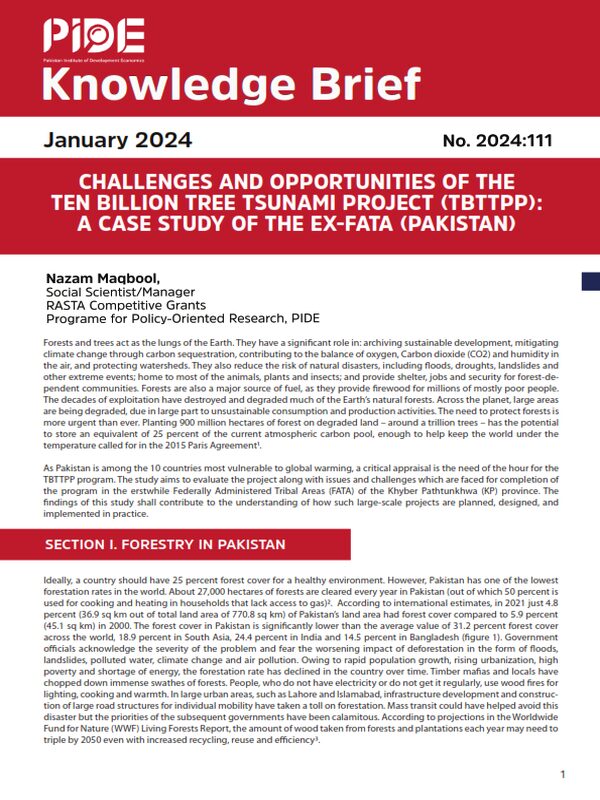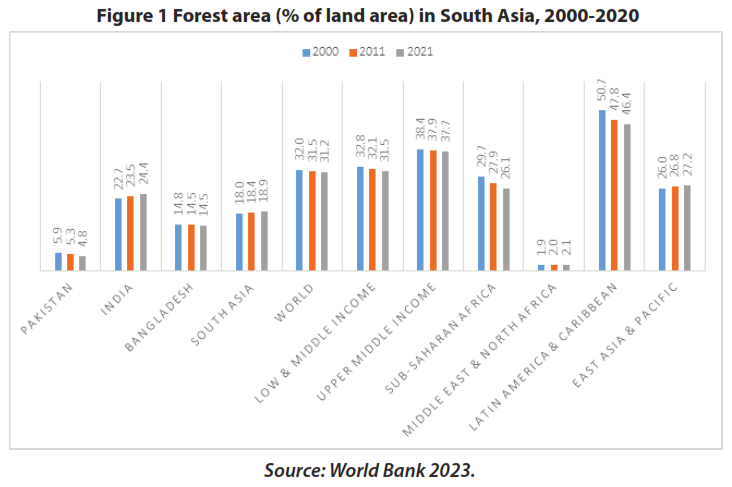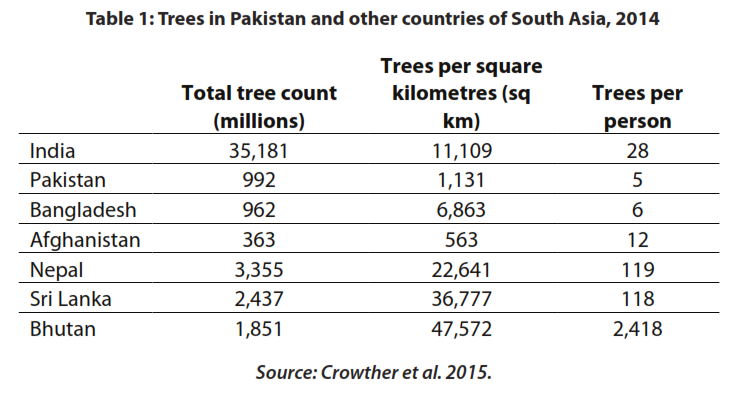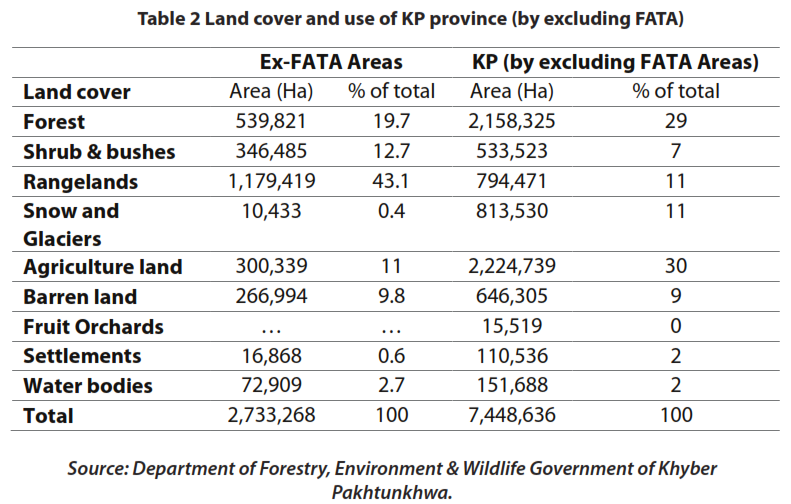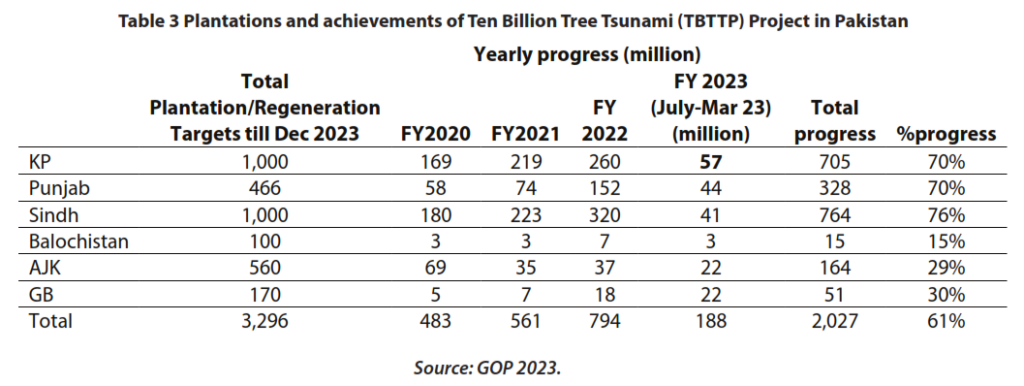
Pakistan Institute of Development Economics
- Home
Our Portals
MenuMenuMenuMenuMenuMenuMenu - ResearchMenuMenuMenuMenuMenuMenuMenu
- Discourse
- The PDR
- Our Researchers
- Academics
- Degree Verification
- Thesis Portal
- Our Portals
Challenges And Opportunities Of The Ten Billion Tree Tsunami Project (TBTTPP): A Case Study Of The Ex-FATA (Pakistan)
Forests and trees act as the lungs of the Earth. They have a significant role in: archiving sustainable development, mitigating climate change through carbon sequestration, contributing to the balance of oxygen, Carbon dioxide (CO2) and humidity in the air, and protecting watersheds. They also reduce the risk of natural disasters, including floods, droughts, landslides and other extreme events; home to most of the animals, plants and insects; and provide shelter, jobs and security for forest-dependent communities. Forests are also a major source of fuel, as they provide firewood for millions of mostly poor people. The decades of exploitation have destroyed and degraded much of the Earth’s natural forests. Across the planet, large areas are being degraded, due in large part to unsustainable consumption and production activities. The need to protect forests is more urgent than ever. Planting 900 million hectares of forest on degraded land – around a trillion trees – has the potential to store an equivalent of 25 percent of the current atmospheric carbon pool, enough to help keep the world under the temperature called for in the 2015 Paris Agreement.[1]
As Pakistan is among the 10 countries most vulnerable to global warming, a critical appraisal is the need of the hour for the TBTTPP program. The study aims to evaluate the project along with issues and challenges which are faced for completion of the program in the erstwhile Federally Administered Tribal Areas (FATA) of the Khyber Pathtunkhwa (KP) province. The findings of this study shall contribute to the understanding of how such large-scale projects are planned, designed, and implemented in practice.
Section I. Forestry in Pakistan
Ideally, a country should have 25 percent forest cover for a healthy environment. However, Pakistan has one of the lowest forestation rates in the world. About 27,000 hectares of forests are cleared every year in Pakistan (out of which 50 percent is used for cooking and heating in households that lack access to gas).[2] According to international estimates, in 2021 just 4.8 percent (36.9 sq km out of total land area of 770.8 sq km) of Pakistan’s land area had forest cover compared to 5.9 percent (45.1 sq km) in 2000. The forest cover in Pakistan is significantly lower than the average value of 31.2 percent forest cover across the world, 18.9 percent in South Asia, 24.4 percent in India and 14.5 percent in Bangladesh (figure 1). Government officials acknowledge the severity of the problem and fear the worsening impact of deforestation in the form of floods, landslides, polluted water, climate change and air pollution. Owing to rapid population growth, rising urbanization, high poverty and shortage of energy, the forestation rate has declined in the country over time. Timber mafias and locals have chopped down immense swathes of forests. People, who do not have electricity or do not get it regularly, use wood fires for lighting, cooking and warmth. In large urban areas, such as Lahore and Islamabad, infrastructure development and construction of large road structures for individual mobility have taken a toll on forestation. Mass transit could have helped avoid this disaster but the priorities of the subsequent governments have been calamitous. According to projections in the Worldwide Fund for Nature (WWF) Living Forests Report, the amount of wood taken from forests and plantations each year may need to triple by 2050 even with increased recycling, reuse and efficiency.[3]
Distribution of the country’s total forest area varies; it is the highest in Khyber Pakhtunkhwa (32.7 percent of total forest area of Pakistan), followed by Sindh (14.8 percent), Punjab (12.4 percent), Ex-FATA (11.9 percent), Balochistan (11.1 percent), Azad Jammu and Kashmir (9.6 percent), and Gilgit-Baltistan (7 percent).[4] Within the forest cover area of the country, dry temperate forests account for the largest share of 36 percent, followed by sub-tropical broadleaved shrub (19 percent), moist temperate (15 percent), Chir Pine (13 percent), Riverine (4 percent), irrigated plantation (4 percent), thorn (3 percent), mangrove (3 percent) and subalpine forests (2 percent).[5]
A look at countries and their total number of trees show that countries with the highest landmass have the highest totals. Russia (642 billion) has the highest number of trees in the world followed by Canada (318 billion), Brazil (302 billion) and the US (228 billion).[6] Pakistan is among the countries with the lowest number of trees in the world with less than one billion trees.
The situation can be explained in a better way by using the indicator of tree density. Pakistan has 1,131 trees per sq km and only five trees per person, which is only higher than Afghanistan in South Asia (table 1). A desirable tree level for sustainable development requires 900 trees per person. Any gap in the desired and actual level of trees per person reflects an impediment to the long-term sustainable development of a country.
South Asia has 11 million hectares of privately owned forests and their area is increasing, with Pakistan and Bangladesh having the highest proportion of privately owned forests (36 and 34 percent respectively in 2010).[7] An increase in the share of private ownership of forests could have serious implications for sustainable forest management in the future. Indigenous people own the least among all categories of forest ownership, and the ratio is on the decline. This may have serious implications not only for forest conservation but also for the empowerment of indigenous people, who are already among the most deprived.
South Asia’s forests provide formal and informal, employment (full-time equivalent) to about 7.9 million, with 6.3 million in India, 1.5 million in Bangladesh and 0.1 million in Nepal. The Billion Tree Tsunami Project in Pakistan has also created over 0.5 million green jobs mostly for rural women and unemployed youth, who are owning 13,000 nurseries as well as community-chosen forests.[8]
____________
[1] Little 2021.
[2] APP 2017.
[3] WWF Pakistan 2017.
[4] World Bank 2018.
[5] GOP 2022a.
[6] World Bank 2018.
[7] FAO 2015.
[8] Amin 2019.
____________
Section II. The Ten Billion Tree Tsunami (TBTTP) Project
The 10 Billion Tree Tsunami Project (TBTTP) was started in 2018 based on the success of the Billion Trees Afforestation Project (BTAP) which was launched in the KP province in 2014.
The BTAP had the following features and achievements:[9]
- 4th biggest initiative in the world
- 1st biggest initiative in Pakistan
- The forest cover of the KP province increased by six percentage points (from 20 percent to 26 percent)
- The forest cover of Pakistan increased by one percent point.
- More than 500,000 green jobs were created.
- Eighty-eight percent survival rate of plants.
- The Project was completed at a reduced cost of Rs. 16.5 billion instead of Rs. 22 billion.
- Through the establishment of 4,509 enclosures, degraded forests have been rehabilitated with the help of the deployment of 4,509 neghbans (chowkidar). WWF has reported that 2,412 seedlings per hectare have been regenerated in the degraded forests.
Inaugurated on September 2, 2018, TBTTPP (Phase 1) was a four-year (2019-2023) project to plant / regenerate 3.29 billion plants in the provinces / territories, with a long-term aim to cross 10 billion trees by 2028. The program was launched by the federal government with a total cost of Rs125.2 billion based on 50 percent contribution by each of the respective provincial Annual Development Plans (ADP) and federal Public Sector Development Program (PSDP).[10] However, in case of AJK and GB, 100 percent funding is being provided under the PSDP by the Federal Government. The programme is being implemented by the provincial forest and wildlife departments through the Federal Ministry of Climate Change. The aim was to revive forest and wildlife resources besides improving the overall conservation of existing protected areas, encourage eco-tourism, community engagement and creation of jobs for youth. The Federal government relaunched the TBTTP program for the FY 2023-24 with the new name ‘Green Pakistan Program’.
As part of the revised PC-1 for the KP province, 1.1 billion plants shall be added to the KP by assisting natural regeneration and afforestation in 6 years (2019-25) against the budget of Rs. 30 billion.[11] After the completion of the project, the forest cover of the province will increase by 4 percent, and over one million green jobs shall be created. It will also restore and rehabilitate degraded forests as well as improve biodiversity. The KP government planned to bring the unutilized land of merged tribal districts under plantation through forest enclosures to achieve target of additional one billion trees, as land was not available in other districts of the province.
2.1. Land Area Utilization in the KP Province: The total forest area of the KP province (including Alpine Pastures) after the merger of Ex-FATA is 2,698,146 hectares or 26.5 percent of the total land area (see table 2). The precious coniferous forest growing on upland watersheds in Malakand and Hazara Civil Divisions and Ex-FATA play a critical role in regulating the country’s irrigation system, maintaining ecology and meeting the livelihoods of millions of dependents. Unfortunately, due to the immense pressure of wood acquisition for fuel and construction more than 70 percent of these forests are rendered depleted.[12] The situation of Ex-FATA is not an exception due to militancy and dependence of locals on natural resources is causing continuous depletion of the forests.
There are ample opportunities to regenerate these forests if nature is given a chance by minimizing human disturbances. Over one-fourth of the land in KP is available for plantations to minimize pressure on the existing forest and meet domestic needs and create livelihood opportunities for the communities. Recently, the province has completed BTAP whereby 6 percentage points of additional land of the province has been brought under forests besides assisting natural regeneration in 20 percent of existing forests. As the area of the province has gone up after the inclusion of the Ex-FATA, the potential for increasing the forest cover has further increased. Therefore, the targets of the instant project have been accordingly fixed. As most of the suitable forests of Malakand and Hazara regions have already been closed under BTAP, therefore, this activity shall mostly be done for the rehabilitation of forests of Ex-FATA.
Enclosures of an appropriate size average of 40 hectares each, shall be established by the appointment of Nigahbans who will be responsible to protect the enclosed forests against fire occurrence and grazing, which are the main factors obstructing natural regeneration. Similarly, for reducing pressure on these forests of fuelwood acquisition, plantations of multipurpose comparatively fast-growing species shall be created on wastelands. Corresponding to the situation of the area different types of plantations are envisaged. In Malakand and Hazara where annual mean precipitation is sufficient for plant growth, no watering is envisaged. Whereas in the southern districts and part of Ex-FATA where hot and dry seasons are the main determinants of the climate, watering plants for initial three years is proposed. Further, in the mountainous areas, soil conservation is integrated with plantations by adjusting plant spacing and adding biological structures and civil works. The physical activities of the project shall be implemented by 35 Forest and Watershed Divisions of the KP Forest Department.
In the project, the establishment of 6,250 enclosures has been envisaged with an estimated 2,400 seedlings per hectare. It is expected that these enclosures will contribute germination of 600 million seedlings. Under-stocked forests and wastelands on private lands having indigenous crops enough to produce seed for regeneration shall be identified. The stakeholding communities of these chunks of the forests shall accordingly be identified and organized into Village Development Committees (VDCs). The areas so identified shall be demarcated in collaboration with the concerned VDC. A community Nigahban nominated by the VDC shall be appointed for protecting the area against any anthropogenic activities particularly free grazing and setting a fire, which is hampering natural regeneration. The Nigahban shall be paid Rs. 18,000 per month. To fence vulnerable points and seed the blanks for getting better results, an amount of Rs. 25,000/- per enclosure has been enhanced to Rs. 100,000 (This amount will be utilized on a need basis and as per site requirements) to enable them to properly fence the vulnerable sites and block the pathways of intruders and grazing animals. These enclosures shall be maintained for consecutive four years. The advanced growth at the time of the establishment of enclosures shall be given due importance as these seedlings would get more vigour during the enclosure period. There are several chunks – both in designated forests and wastelands where due to any reason natural regenerations of coniferous plants of different age groups get the chance to grow undisturbed for 3-4 years, but are always at risk of destruction due to fire. Under this initiative, these chunks shall also be protected for the coming four years or less, keeping in view the site-specific requirements.
2.2. Progress in KP vis-a-vis Erstwhile FATA: The recent progress shows that by March 2023, two billion trees were planted in the country against the target of 3.3 billion by June 2023, reflecting a progress of 61 percent. In case of the KP province, 705 million plants were planted by June 2023 against the target of one billion trees by June 2023, indicating a progress of 70 per cent (see table 3). In the KP, the remaining 300 million saplings would be planted in the extended year (by FY 2024) with the help of forest enclosures, farms forestry and the general public.
Distribution of activity in the KP province shows that up till April 30, 2023, 6,081 enclosures and 337.06 million by farm forestry under the 10 billion trees afforestation project were planted throughout the province since the inception of the project with the breakup. Around 150 million trees were plannted in merged districts.[13] This includes 36.4 million trees in Kurram, 23.2 million trees in South Waziristan, 21.4 million trees in Khyber, 19.7 million trees in Khyber, 18.3 million trees in North Waziristan, 13.7 million trees in Mohmand, and 13.4 million trees in Bajaur.
An analysis of the achievements of TBTTP activities in merged districts (Ex-FATA) shows that the TBTTP was extended to the Merged District Area with the targets of raising 40,497.34 hectare of Plantation. Degraded watersheds are being treated in 10 valleys of the merged areas which will improve the quality and quantity of water. For Assisted Natural Regeneration, 2,000 enclosures are targeted out of which 1,622 enclosures were established by involving the local community. Under the TBTTP, Rs. 7.7 billion (27.2 percent) will be utilized in Merged Districts and the physical targets allotted to the merged area is 31 percent of the total provincial target.[14]
_____________
[9] Department of Forestry, Environment & Wildlife Government of Khyber Pakhtunkhwa.
[10] GOP 2022b.
[11] GOKP 2021.
[12] GOKP 2021.
[13] Buneri 2023.
[14] Department of Forestry, Environment & Wildlife Government of Khyber Pakhtunkhwa.
_____________
Section III. Issues and Challenges for the KP TBTTPP Project
Before the merger of the Ex-FATA with KP, the role of the KP Forest Department was ceremonial in the area and KP Forest Department was restricted only to plantation activities. The KP Forest Ordinance and the Forest Laws were not extended to FATA. Illegal timber cutting, transportation/smuggling and other offences were the responsibility of the Political Administration of each Tribal Agency. Since the merger of the FATA as Newly Merged Areas and each agency declared as a Tribal District and part of the KP, all the laws of the land of the country have been extended to them as well. It is a coincidence that the starting of the Billion Trees Tsunami Program was almost at the same time as the merger of the FATA into KP. The tribesmen who were new to the merger and who were being governed through the Frontier Crimes Regulation (FCR) till the merger had fear of the unknown and the same was also instigated by some political parties.
After a lapse of two years of the project period, only Rs. 7 billion has been spent (against a total cost of Rs. 27 billion for four years) and it will not be possible to achieve the project targets as per plan, with a similar situation in the Ex-FATA regions of the KP province. Furthermore, fewer releases were made during the project period due to the financial crunch and the Pandemic of Covid-19 since March 2020 in the country.
Following are the main challenges, opportunities and threats being faced in the implementation of the TBTTP in Ex-FATA.
3.1. Policy Level Challenges:
Policy level challenges to the program include:
- Implementation of various legal provisions of the KP Forest Ordinance to safeguard Enclosures.
- Organizing communities into VDCs as per Community Participation Rules 2004 where all stakeholder of a village has equal say in the affairs of the committee.
- Reducing the target of “Establishment of Enclosures” from 4,500 to 2,000.
- Implementation of the same project in Ex-FATA as of other settled areas with the same costings and provisions of activities.
- Non-fencing of the project interventions as TBTTP focuses on social fencing and ownership of activities by communities, an altogether shift of the policies in the interventions.
3.2. Implementation Level Challenges in Ex-FATA:
The establishment of the 6,250 “Enclosures” is the core activity of the project through which 500 million saplings are planned to be raised during the project period. So far only 3,600 of enclosures’ target has been achieved. This is partly due to the reluctance of local communities of the Newly Merged Areas of FATA to participate in the activity for the reason that the Government intends to nationalize the existing forests and abolish the ownership/proprietary rights of the local communities. Secondly, the prevailing Law & Order situation and re-emergence of Taliban/insurgency and conflict between the local communities on ownership rights also badly hampered the process of establishment of enclosures.
- Implementation of various interventions of TBTTP in Ex-FATA.
- Ground-level security conditions due to the prevailing state of uncertainty about security.
- De-notification of the appointment of Negahbans due to reservations of the security agencies.
- De-notification of some of the Enclosures due to security risks being faced by the officials.
3.3. Strengths and Opportunities of the Program:
The strengths of the program are its success in the first phase, involvement of local communities in the form of CBOs, transparency, the significant role of enclosures, and more focus on Ex-FATA. The program is offering several opportunities such as employment for the poor and women, ecological sustainability, and alternative livelihoods.
3.4. Weaknesses and Threats of the Program:
The main weaknesses of the program are the provision of sufficient financial resources, sustainability of the program in the long run and lack of sufficient trained staff. Other issues are insufficient coordination among and within provinces, and shortage of staff. The main threats of the program are the lack of trust of locals in Ex-FATA in the government, climate uncertainty, dry weather, conflicts, terrorism, local disputes, and difference in political culture compared to the rest of the province.
Section IV. Conclusion and Recommendations
To make the TBTTP a success, environmental ambitions must be reflected in the overall developmental and economic policy of the country. Following are a few recommendations:
- The government must restore the ban on forest cutting (ironically ended in 2014 by the PTI government in KP) and stop allowing private developers to build on forest land, and follow measures to discourage the use of wood burning for cooking and heating.
- Drastic measures are needed to control the activities of the timber mafia by strengthening the prosecution and Judicial processes to penalize the responsible ones.
- Communities must be educated on the importance of environmental conservation.
- In ex-FATA regions, the provision of better management structures with the provision of better watering, local ownership and trust and fencing needs to be promoted.
- The planting of trees should be made efficient by guiding the farmers about the timely and safe transportation of seedlings, storage and planting and improving the distribution system.
- Planning needs to be improved in the rehabilitation of saline and waterlogged areas and rehabilitation of bad (degraded) sites.
- There is need to improve accountability by allowing the setup of nurseries for the provision of samplings on merit and not by favorites.
- The growers in private nurseries need to be trained.
- The role of community mobilization is vital. The selection of tree species ought to consider local environmental conditions, involvement of local communities, and the economic and social context of the area. There is need to choose species that are best adapted to the local ecology and are either native or naturalized.
- Besides growing fast-growing plants such as Eucalyptus, farmers need to be encouraged to focus on indigenous species by providing incentives like providing honeybee colonies.
- Delays in the release of funds have created uncertainty, doubts and stagnancy. Timely releases of funds are of vital importance for the payment of wages to labourers. There is also need to improve the utilization of funds and make the funding mechanism sustainable for the sustainability of the programme.
- Least but not the least, experts should be appointed planning, execution and sustainability of planting of new trees and for the growth and protection of already planted trees.
Acknowledgments
I would like to express our gratitude to Dr Nadeem Ul Haque, Vice Chancellor of PIDE, for his invaluable input and feedback. Dr Nadeem’s guidance and the insightful ideas to me played an instrumental role in shaping this Knowledge Brief, and I am immensely thankful for his support.
References
Amin, T. 2019. “KP with 25 Percent of Forest Coverage Stands First.” Business Recorder, 7 July.
APP (Associated Press of Pakistan). 2017. “Over 2 Million Trees Planted under Green Pakistan Programme.” The Nation, 1 July.
Buneri, A. 2023. “10 Billion Tree Tsunami Suffers Setback as Flash Floods Devastate Forests.” Pakistan Today, May 06.
Crowther, T. W., H. B. Glick, K. R. Covey, et. al. 2015. “Mapping Tree Density at a Global Scale.” Nature 525 (7568): 201-205.
FAO (Food and Agriculture Organization of the United Nations). 2015. Global Forest Resources Assessment 2015. Rome: FAO.
GOKP (Government of Khyber Pakhtunkhwa). 2021. Ten Billion Tree Tsunami Programme Phase-I, Up-Scaling of Green Pakistan Programme (Revised) (01.07.2019 To 30.06.2025) (6 Years). Peshawar: Department of Forestry, Environment & Wildlife Government of Khyber Pakhtunkhwa.
GOP (Government of Pakistan). 2022a. Economic Survey of Pakistan 2021-22. Islamabad: Ministry of Finance.
GOP (Government of Pakistan). 2022b. From Stabilization to Sustainable Growth: 2022-23 Annual Plan. Islamabad: Ministry of Planning, Development & Special Initiatives.
GOP (Government of Pakistan). 2023. Economic Survey of Pakistan 2022-23. Islamabad: Ministry of Finance.
Little, J. B. 2021. “Lessons from the Rush to Reforest.” The Third Pole, May 19.
World Bank. 2018. “Forests for Green Pakistan.” Forest Policy Note. Washington D.C.: World Bank.
World Bank. 2023. “WDI Online Database.” https://databank.worldbank.org/source/world-development-indicators
WWF (World Wildlife Fund), Pakistan. 2017. “Rebuilding Pakistan’s Forest Cover.” Newsroom, March 21.

